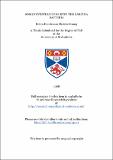Files in this item
Some investigations into the Sarcina bacteria
Item metadata
| dc.contributor.advisor | Thirkell, David | |
| dc.contributor.author | Strang, Robin Henderson Christie | |
| dc.coverage.spatial | 279 p. | en_US |
| dc.date.accessioned | 2018-06-14T08:50:59Z | |
| dc.date.available | 2018-06-14T08:50:59Z | |
| dc.date.issued | 1968 | |
| dc.identifier.uri | https://hdl.handle.net/10023/14041 | |
| dc.description.abstract | 1. Studies on the carotenoid pigments of: S. flava indicated the presence of four main fractions, the amount of each being in direct proportion to its polarity. Little could be discovered about the least polar fraction, containing carotenes, and probably the colourless precursors, except that none of the normal carotene precursors appeared to be present. The three xanthophylls were found to be C50 carotenoids with a chromophore of nine conjugated double bonds. All contained hydroxyl groups. 2. Comparison by spectroscopy and chromatography of the carotenoids of S. flava with those of some other bacteria, indicated that the occurrence of these C50 carotenoids might be quite widespread. S. lutea was found not only to produce the same carotenoids, but also to have the same level of pigmentation as S. flava, when the bacteria were grown under the same conditions. 3. Investigations into the protoplast membrane of S. flava proved conclusively that all the carotenoid was contained within the membrane. A water-soluble fraction was obtained from the membrane, and studies showed that it was a lipoprotein complex, in which the bulk of the carotenoid was tightly bound. | en_US |
| dc.language.iso | en | en_US |
| dc.publisher | University of St Andrews | |
| dc.subject.lcc | QR82.S3S8 | |
| dc.subject.lcsh | Rhodospirillales | en |
| dc.title | Some investigations into the Sarcina bacteria | en_US |
| dc.type | Thesis | en_US |
| dc.contributor.sponsor | Science Research Council (Great Britain) | en_US |
| dc.type.qualificationlevel | Doctoral | en_US |
| dc.type.qualificationname | PhD Doctor of Philosophy | en_US |
| dc.publisher.institution | The University of St Andrews | en_US |
This item appears in the following Collection(s)
Items in the St Andrews Research Repository are protected by copyright, with all rights reserved, unless otherwise indicated.

